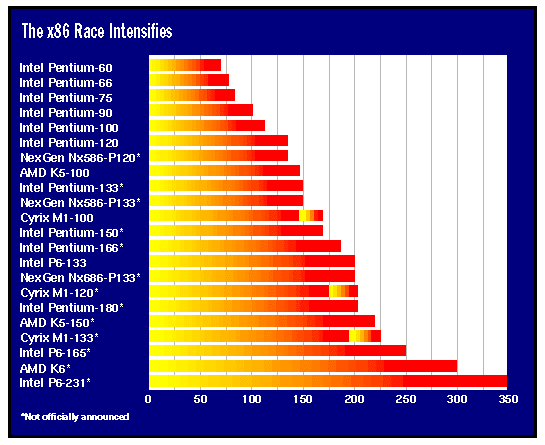| Four companies are currently scrambling to put the
fastest x86 chip in your PC in 1996, and the competition
will make lightning-fast PCs more affordable than ever.
Even as Intel (Santa Clara, CA) prepares to introduce its
sixth-generation CPU this year (see
"Intel's P6," April
BYTE), the company is also working on fifth-generation
Pentiums that will run as fast as 180 MHz. Meanwhile,
Intel announced a 120-MHz Pentium in March. Faster
versions of the Pentium processor — clocked at 133 and 150
MHz — are promised for the end of this year. In addition,
Pentiums clocked at speeds of 166 and 180 MHz are expected
to follow in 1996. A 180-MHz Pentium would likely break the 200-SPECint92 barrier and deliver roughly the same performance as the first P6, which is clocked at 133 MHz. By then, of course, the P6 will be faster, too. Intel plans to introduce a 166-MHz P6 in early 1996 and a 231-MHz version later next year. That would yield an estimated top end of about 350 SPECint92, which would boost the P6 into the stratosphere of the fastest RISC chips. Leading the charge among Intel's rivals is NexGen (Milpitas, CA), which won a great deal of credibility last year by shipping its first Pentium-class x86-compatible processor, the Nx586. (Compaq recently announced it will use NexGen chips in future PCs.) NexGen says it will match the performance of Intel's 120- and 133-MHz Pentiums by midyear, when it delivers P120 and P133 versions of the Nx586. NexGen's P120 chip will actually be clocked at about 112 MHz, and the P133 at about 124 MHz, but their performance will be comparable to that of the slightly faster Pentium chips, due to the NexGen chips' more efficient microarchitectures. NexGen's strategy is to match the Pentium's performance while undercutting Intel's prices. The Nx586 currently costs about 13 percent to 20 percent less than comparable Pentium versions. NexGen's Nx686, a sixth-generation design, will compete head-to-head with Intel's P6. NexGen says it will introduce the still-secret Nx686 "in the same time frame" as the first shipments of the P6, which are anticipated for late this year. According to NexGen, the Nx686 will match or exceed the P6's performance. Cyrix (Richardson, TX), another x86 contender, hopes to release by midyear the M1, a 100-MHz x86 chip that promises to deliver 30 percent to 50 percent more performance than a Pentium running at the same clock speed. Cyrix says that a 120-MHz version of the M1, slated for release at the end of this year, will be followed by a 133-MHz chip in early 1996. If Cyrix can meet those goals — its delivery schedules have already slipped — the M1's performance at 133 MHz should reach 200 SPECint92, which is comparable to the performance of the 133-MHz P6 and the 180-MHz Pentium. Intel's largest x86 competitor, Advanced Micro Devices (Sunnyvale, CA), promises to ship its K5 processor in early 1996. Like the Cyrix M1, AMD's K5 is estimated to be at least 30 percent faster than a Pentium running at the same clock speed. The K5 will debut at 100 MHz; a 150-MHz version will follow. The 150-MHz K5 should easily exceed 200 SPECint92 and compete well against Intel's 133-MHz P6 and 180-MHz Pentium. AMD says that later in 1996 it will unveil the K6, a sixth-generation x86 processor that will attain 300 SPECint92 — performance comparable to that of a 200-MHz P6. Recent history is a good bellwether of how fast system prices will drop due to all these manufacturing improvements: Pentium systems fell below $2000 about twice as fast as 486 systems did after the 486 processor was introduced. It's likely that sixth-generation x86 performance will be affordable by 1997. The x86 Race Intensifies Copyright 1994-1998 BYTE |